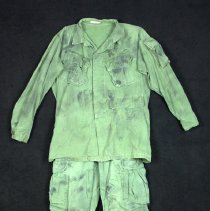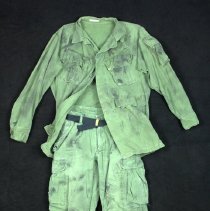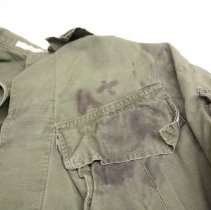Object Record
Images



Metadata
Object Name |
Uniform, Military |
Catalog Number |
1991.064.01 |
Description |
US Army issue green camouflage shirt. Green with random black markings. Five buttons on front. Two breast pockets, one waist pocket on left side, one pocket on left sleeve, all buttoned. Buttoned cuffs. |
Other Name |
Camouflage Jacket |
Provenance |
Used by Gerry Barker |
Used By |
Barker, Gerry |
Date |
c. 1970 |
Event |
Vietnam War |
Material |
Cloth/Plastic |
People |
Barker, Gerry |
Subjects |
"Things that Matter" Military Clothing & Accessories |
Search Terms |
Vietnam War Uniform "Things that Matter" |
Relation |
Show Related Records... |
Notes |
Phone conversation with Gerry Barker, 8/30/2016: Served in the US Army from 1962 to 1984. 16 of his 22 years he was in Special Forces (Green Berets). 72 months combat duty. He parachuted into Laos, information that was declassified in 1993. Barker was the Recon team leader for the "Adder" team. Barker described the uniform as a jungle fatigue uniform, modified for in-country conditions. It was always worn tucked in, to reduce noise. Pockets were moved up from the lower half of the shirt to the shoulders, because casualties never land on their shoulder, and morphine stored in a shoulder pocket was easily accessible. Black spray paint was used to create camouflage. The "A+" painted on the fatigue shirt signified his blood type, since Special Forces teams wore no dog tags or anything else to identify them as Americans when they were on classified missions. Featured in Things that Matter "Former Mindoro-area resident Gerry Barker served in the U.S. Army from 1962 to 1984. For 16 of those years, he was in the Special Forces and served 72 months of combat duty in Southeast Asia. Special Forces — also known as the Green Berets for their distinctive headgear — played a significant role in undercover and dangerous operations in Vietnam, often sending out small groups of soldiers into remote areas controlled by enemy forces. They also trained and assisted indigenous forces. One of Barker’s missions found him parachuting into Laos, and he also served as a reconnaissance team leader. This jungle fatigue uniform was worn by Barker as a member of the Special Forces. Barker described this uniform as having been modified for conditions encountered in Vietnam, Cambodia and Laos. He said the jacket always was worn tucked in to reduce noise while he moved through the countryside. Pockets were moved up from the lower jacket or pants to the shoulders. Barker explained that wounded soldiers never land on their shoulders, and morphine stored in a shoulder pocket was more easily accessible than in a front pocket. The camouflage was created by using black spray paint on the clothing. In addition, an "A+" was painted on the fatigue jacket to indicate his blood type should he be wounded. Special Forces teams wore no dog tags or anything else to identify them as Americans when they were on classified missions, such as the ones Barker took into Laos. After Barker retired from the service in 1984, he earned a degree in history and for a few years was employed by the La Crosse County Historical Society as curator. It was during this time that he donated this jungle fatigue uniform as well as his master sergeant Special Forces dress uniform with his Special Forces Airborne patch, service bars and combat service bars. Gerry Barker also donated the distinctive green beret he wore with that uniform." This article was originally published in the La Crosse Tribune. Title: Special Forces Jungle Fatigue Uniform Author: Robert Mullen Publish Date: September 3, 2016 |